

Coorg: A Little Mountain R&R
March 6-10, 2003
are everywhere, as well as hibiscus in so many colors, adding to the beauty of the valley views between the tall shade trees.
Lilian is not only responsible for the gardens, she also runs the house. In charge of the kitchen and the shopping she proves to be an invaluable source of information about Coorg culture. Living in the mountains must be very different
Hampi: Marital Bliss
February 25, 2003
We were atop Hemakuta Hill examining a complex of ruined Jain temples illuminated by early morning sunlight when we first heard the music below. It was faint, but bright-sounding, and came from the Hampi Bazaar just next to the Virupaksha Temple. The fanfare of trumpets and boisterous drumming beckoned us down the hill and into the Bazaar where a crowd had formed, but not around the musicians, rather next to them. The subject of everyone's attention was a young woman whom they were rigourously adorning with garlands of jasmine buds. These were the preparations for a Hampi wedding ceremony.
The bride, groom, and wedding party made their way into the temple complex. Quick to follow, we paid our 4-rupee admission fee, left our sandals with the shoe wallah, and hobbled across the hot stone colonnade. In the middle of the temple sanctuary, surrounded by 15th-century granite columns and friezes, the crowd assembled, and sat upon the floor. The bride and groom sat facing their guests and a gaggle of attendants formed behind them. To the left of the couple was the officiator, a tall, lanky man with a simple white cotton sheath wrapped around his waist. The musicians made their way to the adjacent arcade, their sinuous sounds evocative of music that would accompany a belly-dancer or be employed by a snake charmer.
Women wore a panoply of colors. The bright gold of their bulbous earrings and long, slender necklaces matched the gilded edges of the 15-foot pieces of cloth wrapped intricately around their bodies. The groom was well-groomed in a white, nehru-collared shirt and trousers with a long yellow scarf hanging from his neck. A strand of light coral-colored beads was fixed on two sides of a white tri-cornered hat so it draped across his forehead, the two ends falling at his temples. Orange flowers and a corsage of white jasmine decorated his neck and wrist. Lavishly attired, the bride wore a blue and red plaid shawl and an imperial purple cape, under which on could see traces of an orange sari and scarf; white and orange flowers adorned her black hair, as did a "veil" of red with golden lace. Several garlands were placed around her neck and her strand of beads and corsage matched those of the groom's.
All functions assigned and everyone in their place, the events that followed were a feast for the senses. Women poked and prodded at their saris, adjusted and re-adjusted the strings of jasmine buds in their hair, cuddled and disciplined small children, and shouted orders to the bride's attendants. The men walked about the sanctuary often forming intimate groups for brief conversations, examined features of the temple, taunted the musicians, and offered us rides in their rickshaw ("tomorrow you go to Royal Palace? I have rickshaw!"). The children harassed smaller children and parents, banged on a giant drum suspended from the temple arcade, and entertained themselves by running about and devising all kinds of impromptu games. They were completely aware of Zach and me, would coyly approach and ask us what our country was, could we give school pen or one rupee. A man wandered through the crowd with a small silver bowl of red powder dotting foreheads with the third eye while another attendant carried a larger silver bowl with dry, colored rice and distributed a handful to each guest (including the two of us). The officiator fussed over a gold tray which held candles, incense, a dried coconut, more jasmine flowers, and a small pitcher. Candles and incense were lit, coconut milk was poured from the pitcher, flowers were strewn about, and the bride's attendants became preoccupied with her veil, shawl, and cape which were constantly slipping off her head and shoulders. Another man, perhaps father of the bride or groom, began to argue with the officiator over the ceremony rituals, becoming hostile at times, while the groom remained expressionless and seemed almost oblivious to (or numbed by) the chaos surrounding him. Impatient children and short-term guests prematurely threw their handfuls of rice over the couple, only fueling the father's anger.
A hot wind blew, sandalwood incense smoked, candles burned, tourists came and went.
Finally, the large silver bowl of rice was placed in front of the bride and groom. They took turns cupping their hands, dipping them into the bowl, and pouring the kernels over each other's heads, a gesture that brought smiles to their faces for the very first time. The right end of the groom's yellow scarf was then tied to the left end of the bride's orange scarf and the wedded couple rose. Grinning from ear to ear the father frantically wove his hands over his head, rice flew through the air, and the musicians began to play once more. The entire party paraded around the sanctuary before exiting the temple and within minutes the trumpets and drums sounded faint, but bright, just as they had from Hemakuta Hill earlier that morning.
--A







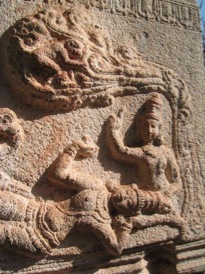


Vittala Temple (above and below)

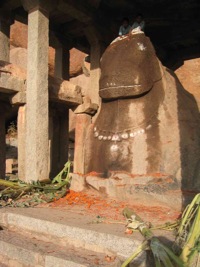

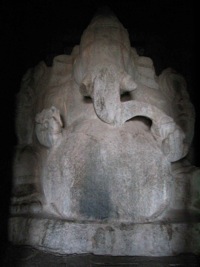

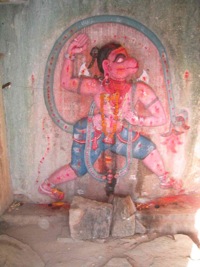
Nandi.
Ganesh.
Hanuman.
We are tired. Traveling through India in the heat of the dry season is a real strain. Dust, pollution, and the strong tropical sun are wearing us out. On top of that the ancient ruins get a little repetitive, and the cities very stressful. Even the gems like Badami and the surreal Hampi wear thin. So we arrange for a home-stay up on a coffee plantation (another connection through our food inquiry on the Thorntree).

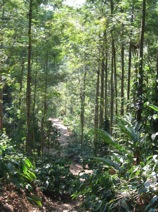
The process of getting there makes it immediately clear that this isolated place is exactly what we are looking for. First a three-hour bus ride from Mysore to Madikeri takes us from the hot, dry flats of the Deccan Plain to the relatively cool, rolling green hills of the Western Ghats. The road is not too bad, but our seats in the very back of the bus amplify every twist, turn, and pothole. On top of that our driver is something of a speed freak (even by Indian standards), passing rival buses on the outside of blind turns and taking a few potholes fast enough for Amy and I to rise a foot off of our seats.

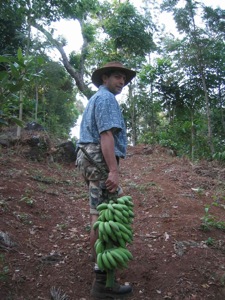
Alex, our host, meets us at the bus station. We load our bags into his Mahindra jeep and set off for his 100-acre plantation. Alex is not a typical Indian. In fact, he probably is just as comfortable in the Appalachian Mountains as he is in the Western Ghats, having spent four years in
West Virginia getting an engineering degree and an MBA. He always loved home, and the death of his father only enhanced his desire to take over the family farm. We learn all of this on the 30 minute drive from Madikeri to Madapur where we stop for supplies. From there it is another 15 minutes, almost straight up the mountain, to the plantation.
The setting is stunning. We leave the main road and turn into a forest full of coffee trees. Alex's mother, Lilian, has lined the steep dirt track with flowering shrubs, mostly hibiscus and giant poinsettias, all of which thrive in these tropical mountains. Adding to the greens and reds are the coffee blossoms, stark white, perfuming the air like jasmine. Just this short drive is exotic, and we're not even home yet. The house sits in the middle of a hard-packed dirt yard (for drying the harvest) which is carved into a ridge. Flowers fringe the yard and blanket the entire house. Orchids and lilies
into a blissful laziness. Each morning Alex gets up for an early walk around the property with his five dogs. Joining him on occasion proves a real workout. Walking up and down the coffee covered slopes is hot work, but the cool air, especially on the top of the ridge, provides a nice respite. Two young dachshund puppies steal the show, chasing each other up and down the trail, tackling one another, or themselves more often then not. It really is amazing how they keep up on their short stubby legs. Afternoons, full of lunch, are best spent napping in the cool shade of the tile-roofed house. We end our days out in the cool breeze on the veranda, enjoying the company of our hosts and watching the geckos at their nightly feast.

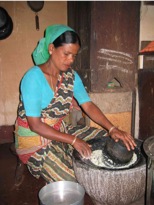

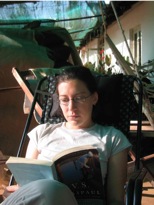
from where she grew up in the coastal city of Mangalore. Many of the conveniences available in other places just do not exist. Something as simple as making dosas (the ever present sour South Indian crepe for breakfast) starts off with grinding the moist rice and gram together with a huge, granite mortar and pestle. The hot water for the bucket bath is heated in a copper pot set into the inside wall over a wood fire just outside the house. The power goes off at least twice a day, and to keep the noisy generator from spoiling the silence kerosene lamps are in constant use. A peaceful, rustic setting to kick back and relax in.
What can I say about our time up in the mountains. . . . The beauty of the setting and the heat of the day combine
monks, in their orange robes, ride the latest motorcycles. At Camp 1 we find a restaurant for lunch back behind a shop serving only luke warm noodles with savory ground meat dumped on top. Not exactly satisfying, but the locals certainly seem to enjoy it.
On the way out of town Alex spots his friend Mac driving along the highway. At his invitation we stop at a small farm to partake of ice-cold neera, just harvested that morning. Neera is sweet palm sap that quickly ferments if it is not refrigerated. After just a few hours it tastes like a slightly sweet, coarse, unhopped lambic. The cold stuff we are drinking is like refreshing nectar, perfect while sitting in the shade on a hot day.
Back up in the mountains we relax, drink excellent coffee and replenish our bodies with tasty food. While we are still in India this stop over, with its warm hospitality, provides us with some much needed rest before our adventure continues.
--Z

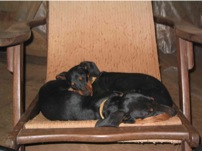


The furthest afield we venture is back out to the Deccan Plain to check out a Tibetan refugee settlement. On the way we stop in Suntikoppa to check out their weekly market. Bright, colorful mountains of vegetables hide the vendors. The smells of spices and cooking snacks are potent. After Alex picks up supplies for the next few meals we continue down the mountains to the flats. The settlement itself was anything but refugee. In the 45-odd years since they were granted the land by a sympathetic Indian government the Tibetans have really thrived. Even the

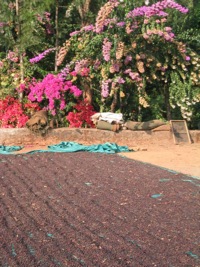

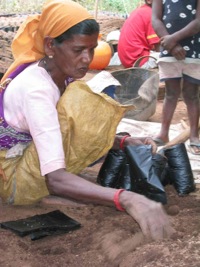

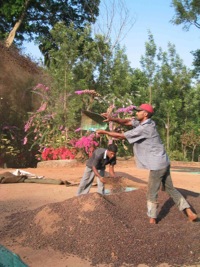



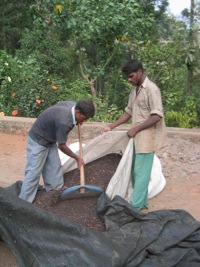

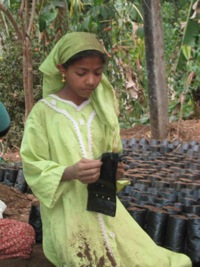
Southern Karnataka: Belur & Halebid
March 11-13, 2003

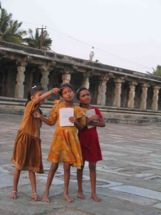

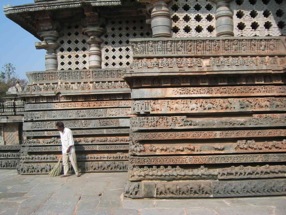

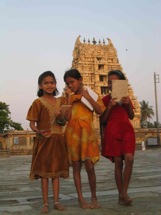
Heritage study, Belur.
Hoysala temple to Vishnu, Belur.
Hoysala temple to Shiva, Halebid.
Southern Karnataka: Sravanabelagola
March 14-15, 2003
We liked this Jain pilgrimage site. The huge statue (58 feet) carved from a single piece of granite looks like it was carved not in the 10th century, but yesterday. At the base of the mountain is a laid back town, with friendly people. The temple provided us an opportunity to watch a pooja (ceremony), complete with fast and loose music.



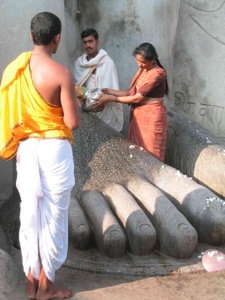

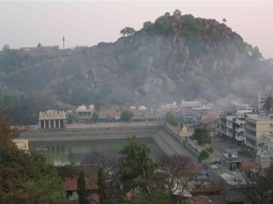

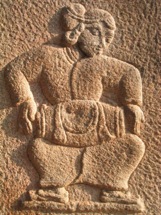

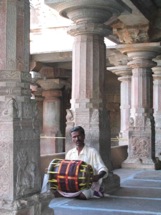

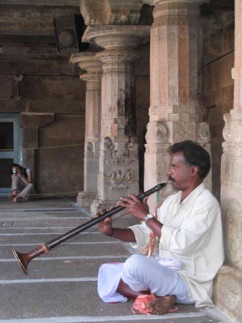

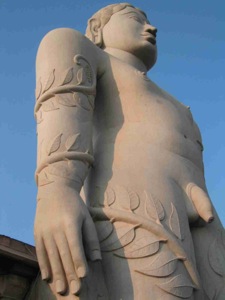
10th century tavil player.
21st century tavil player.
Jain sunset.
Sri Gomatheswar, carved over 1000 years ago.
Pooja!
Nadhaswaram player.
Morning view from step 247.

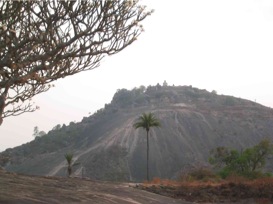
Tomorrow: 614 steps to the top.
Photographs and Text: Copyright 2002 & 2003, Zachary Maler & Amy Leffert